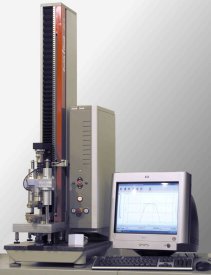Sappi employs 16,000 people worldwide and is the leading supplier of coated fine paper. These products are used in a variety of applications, including books to wine labels, as well as magazines, brochures, catalogues and calendars.
 The Zwick crease tester.
The Zwick crease tester.
Processing of printed sheets after printing is the final production step for printed products. During clinching and creasing, paper experiences strong mechanical stresses, and in unfavourable conditions, the paper’s surface may burst or the fibre structure may break.
The human eye is able to detect this lack of quality very easily on printed surfaces, so it must be avoided. Premium coated papers are extremely sensitive to burst effects in the creasing area. Correct creasing is of paramount importance to avoid such complaints during paper processing in printing shops or in book binding.
To investigate the clinching and creasing properties of paper, different tests are carried out in a paper laboratory. These tests simulate the creasing action, but a significantly lower speed is used compared to the clinching or creasing in today’s modern production lines.
If lower creasing speed is applied, paper is stressed much more than in the production conditions. This means that by using slow laboratory creasing instruments, the paper is damaged much earlier than in production, and so the data produced regarding superficial bursts or web breaks tends to be exaggerated.
Dynamic laboratory die cutters provide a high working speed which is comparable to the creasing machines used in production, and could compensate this disadvantage, but as they are expensive, large and noisy, they are not usually found in the paper laboratory.
As testing machines are frequently used in the paper industry, the idea was to develop a more suitable crease testing system using a modern computerised materials testing machine capable of generating sufficient acceleration and speed. Having developed the testing system the next step was to correlate the test result data from the laboratory and transfer this to the creasing punches in the production line. This process allowed Sappi to optimize the creasing process on the final product.
The creasing tool has a modular design which means that the creasing die and creasing blades can be exchanged with high precision, which allows the use of the optimal combination of blade and die. The creasing process operates according to the following sequence:
- Creasing parameters are fixed (die and blade width, creasing depth, creasing speed)
- After the start of the test, the blade moves towards the specimen and into the die, then continues up to the preset creasing depth. The paper is now creased. The creasing force and blade travel are monitored and stored.
- The creasing blade moves back into initial position.
The results of the new test system were compared with the following methods:
- Visual check according to DIN 55437 part 2
- Measurement of the bending moment and calculation of the clinching factor according to DIN 55437 part 3
- Surface profile measurement, which easily distinguishes between correct and bad creasing (see Fig. 6).
The advantages of the new method compared to conventional creasing are:
- The required creasing depth can be preset in Zwick’s testXpert® software and can be set to an accuracy of 2 to 5 µm.
- The test results can be correlated and transferred to creasing punches in a production line.
- The method is perfectly suited both for process control and for product development.
Based on these positive results, which had been achieved in close cooperation with Zwick´s Competence Centre of paper and board, and the Paper Technology Foundation Munich (PTS) Sappi has now released this as a standard test procedure.